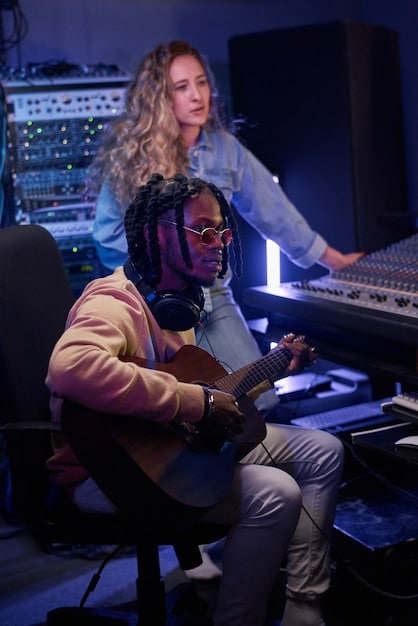Revealed: The Secret Formula Behind a Chart-Topping Pop Song – Deconstructed!

Unraveling the mystery of pop music’s infectious appeal, this article delves into the precise components and creative processes that culminate in a universally beloved, chart-topping hit, offering a comprehensive deconstruction of its core elements from melody to marketing.
Ever wondered what makes a song stick in your head, climb the charts, and resonate with millions? The allure of a Revealed: The Secret Formula Behind a Chart-Topping Pop Song – Deconstructed! might seem like magic, but behind every global phenomenon lies a meticulously crafted fusion of art, science, and strategic execution. This article journeys into the heart of pop music to uncover these often-hidden ingredients.
The Anatomy of a Hit: From Concept to Catchiness
A chart-topping pop song isn’t born overnight; it’s a carefully assembled mosaic of elements designed to captivate and endure. From the initial spark of an idea to its polished final form, every stage of creation is geared towards maximum impact and memorability. Understanding this journey requires delving into the fundamental components that make a song resonate.
Consider the role of melody, arguably the most immediate and impactful element of any song. A strong melody is inherently singable, often featuring repetitive, hook-driven phrases that are easy to recall. These melodic contours are frequently simple, allowing for broad appeal across diverse musical tastes. The magic often lies in their unexpected twists or subtle variations that keep the listener engaged without being overly complex.
Melodic Hooks and Lyrical Resonance
The truly unforgettable pop songs possess melodic hooks that embed themselves deep within the listener’s memory. These aren’t just random sequences of notes; they are meticulously crafted sequences, often ascending and descending in predictable yet pleasing patterns. The simplicity here is key, enabling quick assimilation and retention, which is crucial for radio play and viral spread.
- Repetitive Phrasing: Short, memorable melodic phrases that repeat throughout the chorus.
- Optimized Range: Melodies often stay within a comfortable vocal range for ease of singing along.
- Emotional Arc: Melodies are designed to evoke specific emotions, from euphoria to melancholy.
Beyond melody, the lyrics serve as the song’s narrative backbone. While pop lyrics are sometimes criticized for being simplistic, their effectiveness often lies in their directness and universality. Themes of love, heartbreak, triumph, and identity are consistent staples, presented in ways that allow broad identification. The language used is typically accessible, avoiding overt complexity or ambiguous metaphors, which ensures wide understanding across demographics. The synergy between melody and lyrics is paramount; a compelling story amplified by an infectious tune creates an indelible impression.
The initial concepts for these songs often emerge from collaborative songwriting sessions, where diverse perspectives converge to refine ideas. This collective brainstorming allows for a wider net of experiences and emotions to be drawn upon, increasing the likelihood of widespread resonance. This iterative process of refinement, where ideas are tested and discarded until the perfect combination is found, is a hallmark of successful pop music creation.
Production Prowess: Crafting the Sonic Landscape
Once a song is written, its journey to chart domination hinges significantly on its production. Modern pop production is an intricate art form, blending sophisticated technical skills with an intuitive understanding of what makes a track feel contemporary and compelling. The producer acts as an architect of sound, meticulously layering instruments, vocals, and effects to create a cohesive and impactful sonic landscape.
A hallmark of chart-topping pop is its pristine audio quality. Every element is engineered to cut through the noise, particularly on various playback systems, from high-fidelity headphones to car stereos and streaming platforms. This sonic clarity is achieved through meticulous mixing and mastering, processes that ensure balanced frequencies, impactful dynamics, and an overall polished sound. The subtle interplay of bass lines, drum patterns, synth textures, and vocal harmonies contributes to a rich, immersive listening experience that compels repeated plays.
The Role of Arrangement and Sound Design
The arrangement of a pop song dictates how its various elements unfold over time. This involves strategic decisions about when instruments enter and exit, how dynamics build and release, and where sonic surprises might be introduced. A well-arranged pop song often features a clear structural blueprint: verse-chorus-verse-chorus-bridge-chorus-outro. This predictability allows listeners to easily follow along while still offering opportunities for creative variations.
- Dynamic Shifts: Employing variations in volume and intensity to create excitement.
- Layering Techniques: Stacking multiple sounds to create fuller, richer textures.
- Pre-Chorus Build: Utilizing rhythmic and melodic tension to maximize chorus impact.
Sound design, on the other hand, deals with the specific character and qualities of individual sounds. This includes choosing the right synth presets, processing vocals with particular effects like auto-tune or reverb, and selecting drum samples that provide the desired punch and groove. Producers often spend countless hours experimenting with different sounds to find those that perfectly complement the song’s mood and message. The advent of digital audio workstations (DAWs) has revolutionized this process, allowing for unprecedented manipulation and customization of sounds.
The judicious use of effects, such as reverb, delay, and compression, adds depth, polish, and sparkle to a track. These effects are not merely cosmetic; they play a crucial role in shaping the emotional impact and perceived professionalism of the song. For instance, a touch of reverb can make a vocal feel more ethereal, while aggressive compression can make drums punchier and more direct. Ultimately, the goal is to create a sonic experience that feels both familiar and refreshingly new, drawing listeners in and keeping them enveloped in the music.
The Collaborative Crucible: Songwriting and Production Teams
The journey to a chart-topping pop song is rarely a solitary one. Instead, it’s a testament to the power of collaboration, involving a diverse array of talented individuals who contribute their expertise at various stages. From initial songwriting to final production, these teams operate as a well-oiled machine, each member bringing a unique skill set to the table, ensuring that the song evolves into its most potent form.
Songwriting camps, for instance, have become a cornerstone of modern pop music creation. These intensive sessions bring together lyricists, melodicists, and producers, fostering an environment where ideas can be rapidly generated, tested, and refined. This collective brainstorming accelerates the creative process, allowing for a broader range of influences and perspectives to shape the song. It often leads to unexpected breakthroughs and the development of hooks that might not have emerged from individual effort.
Synergy Between Artists, Writers, and Producers
The dynamic between the performing artist, the songwriters, and the producers is paramount. While the artist brings their unique voice and vision, the songwriters craft the narrative and melodic structures, and the producers translate these raw materials into a polished, commercially viable recording. This trifecta often works in close harmony, with constant feedback loops ensuring alignment on the song’s direction and emotional core.
- Shared Vision: All parties align on the song’s core message and desired impact.
- Constructive Feedback: Open communication fosters refinement and improvement.
- Role Specialization: Each individual contributes their strongest skills to the project.
In many cases, a song might start with a simple demo conceived by a songwriter, which is then brought to a producer who helps flesh out the arrangement and sonic palette. The artist then adds their vocal performance, often collaborating with vocal producers to enhance delivery and emotion. This iterative process, where the song passes through multiple hands, each adding a layer of expertise, is what transforms a good idea into a great record.
Moreover, the industry has seen a rise in “topliners” – individuals specializing in creating compelling melodies and lyrical hooks over pre-existing instrumental tracks. This specialization further streamlines the hit-making process, allowing for efficient development of catchy elements. The collective intelligence and specialized skills of these collaborative teams are undeniable forces behind the consistent production of hit after hit, proving that music is often a team sport.

The Science of Sound: Psychological Impact and Repetition
Beyond the artistic and technical aspects, the success of a chart-topping pop song often lies in its ability to tap into fundamental principles of human psychology. Music, at its core, is a powerful tool for emotional manipulation and cognitive engagement. Hit songs leverage this by understanding how the human brain processes sound, melody, and rhythm, often employing repetition and familiar structures to solidify their impact.
The concept of “mere exposure effect” plays a significant role in pop music’s pervasive appeal. The more frequently we hear a song, the more likely we are to develop a preference for it, even if our initial reaction was lukewarm. Radio undeniably leverages this, playing popular tracks repeatedly, thereby increasing familiarity and acceptance. This constant reinforcement helps embed the song deep within our auditory memory, making it feel comfortable and enjoyable over time.
Cognitive Hooks and Emotional Resonance
Pop songs are masters of creating “cognitive hooks” – elements that are easily processed and remembered by the brain. This includes predictable chord progressions, simple rhythmic patterns, and clear, concise lyrical narratives. The brain is wired to seek patterns, and pop music delivers them in spades, creating a sense of predictability and satisfaction that encourages repeat listening.
- Predictable Structures: Verse-chorus-bridge format offers comforting familiarity.
- Pulsating Rhythms: Driving beats often align with human heart rates, creating an energetic connection.
- Universal Themes: Tapping into common human experiences for broad relatability.
Furthermore, the emotional resonance of a pop song is meticulously engineered. Producers and songwriters consciously choose musical keys, tempos, and instrumental textures that evoke specific feelings. Upbeat major keys often lead to feelings of joy and optimism, while slower tempos can convey melancholy or introspection. The interplay of these elements creates an emotional journey for the listener, whether it’s an exhilarating dance track or a poignant ballad.
The strategic use of repetition, particularly in the chorus, is another psychological cornerstone of pop music. The chorus is typically the most memorable part of the song, containing its main lyrical and melodic hook. Repeating it multiple times ensures that it becomes ingrained in the listener’s mind, making the song easy to recall and sing along to. This deliberate repetition is not just about catchiness; it’s about making the song feel like an indispensable part of cultural consciousness, driving its longevity and chart success.
Distribution and Marketing: Pushing the Song to the Masses
Even the most perfectly crafted song won’t become a chart-topper without a robust distribution and marketing strategy. In the highly competitive music industry, simply releasing music is no longer enough; it requires a concerted effort to push the song to various platforms and cultivate an eager audience. This involves a multi-faceted approach, leveraging traditional channels alongside cutting-edge digital tactics to ensure maximum exposure.
Radio historically played a dominant role in breaking new artists and songs, and while its influence has somewhat diversified, it remains a critical component. Strategic relationships with radio programmers are essential for securing airplay, as consistent rotation on popular stations can quickly introduce a song to millions of listeners. Beyond terrestrial radio, satellite radio and online radio platforms also provide crucial avenues for discovery and exposure.
Digital Dominance and Social Media Amplification
The digital age has revolutionized music distribution and marketing, shifting much of the focus to streaming platforms and social media. Services like Spotify, Apple Music, and Amazon Music are now the primary avenues for music consumption, making playlist placement immensely valuable. Getting a song onto influential editorial or user-curated playlists can exponentially increase its reach and streaming numbers.
- Playlist Pitching: Directly submitting tracks to curators for placement consideration.
- Algorithmic Optimization: Designing content to appeal to platform recommendation engines.
Fan Engagement: Building community through interactive social media content.
Social media platforms like TikTok, Instagram, and YouTube have become indispensable tools for viral marketing. A short, catchy snippet of a song going viral on TikTok, for example, can lead to an explosion in popularity, driving streams and generating buzz. Artists and labels actively engage with these platforms, creating challenges, behind-the-scenes content, and engaging visuals to encourage user-generated content and organic promotion. This organic spread is often more effective and authentic than traditional advertising.
The role of publicists and marketing teams is to orchestrate these various efforts, from securing media coverage and interviews to planning elaborate music video releases. They work to build a narrative around the artist and the song, creating buzz and anticipation. Moreover, partnerships with brands and sync placements in film, television, or commercials can significantly broaden a song’s audience and generate additional revenue streams. In essence, the journey from creation to chart success is as much about strategic placement and persistent promotion as it is about musical brilliance.
The Evolution of Pop: Adapting to Changing Tastes and Technologies
Pop music, by its very nature, is in a constant state of flux. To remain at the top of the charts, artists and producers must possess an uncanny ability to adapt to evolving musical tastes, emerging technologies, and shifts in cultural zeitgeist. What resonated with audiences a decade ago might feel dated today, illustrating the dynamic nature of this genre. This continuous evolution is what keeps pop music fresh, relevant, and endlessly fascinating.
Technological advancements have perhaps been the biggest catalyst for change in pop. From the advent of synthesizers and drum machines in the 1980s to the proliferation of digital audio workstations (DAWs) and AI-powered tools today, technology consistently reshapes how music is created, produced, and consumed. These tools democratize music creation, allowing more producers and artists to experiment with cutting-edge sounds and techniques, which in turn influences the broader sound of pop.
Genre Blending and Cultural Influences
One of the most significant trends in modern pop is its increasing willingness to blend genres. Boundaries between pop, hip-hop, R&B, EDM, and even country or Latin music are blurring, creating hybrid sounds that appeal to wider audiences. This cross-pollination enriches the pop landscape, bringing fresh perspectives and innovative sonic textures. The globalized nature of music consumption, largely thanks to streaming, further fuels this trend, as artists draw inspiration from diverse musical traditions worldwide.
- Global Fusion: Incorporating elements from international music styles.
- Hip-Hop Integration: Rap verses and trap beats are common in pop hits.
- Electronic Influence: Dance music elements frequently infuse pop productions.
Cultural influences also play a vital role in shaping pop music’s trajectory. Social movements, political landscapes, and shifts in societal values often find their way into lyrical themes and artistic expressions. Pop music, being a reflection of popular culture, often serves as a soundtrack to these broader changes, providing anthems for different generations and moments in time. Artists who can tap into these deeper cultural currents often achieve a resonance that transcends mere entertainment.
The challenge for pop artists and their teams is to strike a delicate balance: staying true to their artistic vision while remaining commercially viable. This often involves anticipating trends, embracing new sounds, and being open to radical experimentation. The continuous reinvention of pop ensures its longevity, constantly pushing creative boundaries and redefining what a “hit song” sounds like for the next generation of listeners. It’s a genre that thrives on innovation, propelled by a relentless pursuit of the next big sound.

The Intangible Spark: Charisma, Performance, and Timing
While melody, production, and marketing are crucial, there’s an undeniable, often elusive, element that elevates a song from hit to phenomenon: the intangible spark. This spark encompasses the artist’s charisma, their live performance prowess, and the serendipitous timing of a song’s release. These factors, though harder to quantify, often determine the ultimate breadth and depth of a song’s impact.
An artist’s charisma is their magnetic appeal, their ability to connect with an audience on an emotional level. This isn’t just about vocal talent; it’s about personality, stage presence, and authenticity. When an artist genuinely embodies the emotion and message of their song, it creates a powerful bond with listeners, making the music feel more personal and immediate. This connection often transcends language barriers, allowing songs to resonate globally.
Live Performance and Media Presence
Live performance is a critical arena where this charisma truly shines. A song might be great on record, but a captivating live show can elevate it to legendary status. Artists who can command a stage, engage with their audience, and deliver a memorable performance amplify the song’s energy and emotional impact. These experiences foster deeper fan loyalty, translating into sustained engagement and continued chart success.
- Authentic Connection: Engaging fans with genuine emotion and interaction.
- Visual Spectacle: Incorporating compelling visuals and choreography.
- Immersive Experience: Creating an atmosphere that draws the audience in.
Beyond live shows, an artist’s media presence – including interviews, music videos, and social media interactions – plays a vital role. How an artist presents themselves, articulate their vision, and interacts with their fanbase all contribute to their public persona. A well-managed media presence can amplify their message, draw new fans, and sustain interest in their work long after a song’s initial release. This sustained visibility is crucial for maintaining momentum.
Finally, timing is often underestimated in its importance. The cultural zeitgeist, current social trends, or even global events can create a receptive environment for certain types of songs. A song released at just the right moment, perhaps echoing a collective sentiment or providing an emotional escape, can achieve an unparalleled level of resonance. This combination of artistic brilliance, strategic execution, and a touch of serendipity is often the true secret behind a chart-topping pop song, turning notes and words into cultural landmarks.
| Key Element | Brief Description |
|---|---|
| 🎶 Catchy Melody & Lyrics | Infectious tunes and relatable words for easy recall and broad appeal. |
| 🎛️ Polished Production | High-quality sound engineering, mixing, and mastering for a professional sonic experience. |
| 🤝 Strategic Collaboration | Teamwork among writers, artists, and producers to refine and optimize the song. |
| 📈 Effective Marketing | Aggressive digital and traditional promotion to ensure widespread visibility and listens. |
Frequently Asked Questions About Pop Song Hits
▼
While there’s no strict rule, pop songs optimized for radio and streaming often range from 2 minutes 30 seconds to 3 minutes 30 seconds. This length balances sufficient development with keeping the listener engaged without causing fatigue, ensuring higher completion rates on streaming platforms and fitting well into radio programming blocks for repeated plays.
▼
Social media is critically important. Platforms like TikTok, Instagram, and YouTube can catapult a song into virality, often more effectively than traditional marketing alone. Short, engaging snippets and user-generated content challenges can create massive buzz, driving streams, fan engagement, and ultimately, chart performance by reaching a vast, interconnected global audience directly and authentically.
▼
Absolutely. The chorus remains the heart of a pop song and its most memorable component. It typically contains the main melodic and lyrical hook, designed to be easily singable and deeply ingrained in the listener’s mind. A strong, repeatable chorus is essential for a song’s longevity, its appeal on radio and streaming, and its ability to inspire singalongs at concerts.
▼
Producers are pivotal in translating a song’s core idea into a polished, commercially viable record. They oversee arrangement, sound design, mixing, and mastering, ensuring pristine audio quality, innovative sonic textures, and emotional impact. Their technical expertise and creative vision shape the song’s overall feel, making its sound distinct and appealing to a mass audience across various playback environments.
▼
Genre blending can significantly enhance a pop song’s success by broadening its appeal. By incorporating elements from other genres like R&B, hip-hop, or EDM, pop songs can attract diverse listener bases and sound more fresh and innovative. This cross-pollination often leads to unique sounds that stand out in a crowded market, reflecting the increasingly global and eclectic tastes of modern audiences.
Conclusion
The journey of a song from conception to chart-topping hit is a fascinating blend of artistic inspiration, meticulous craftsmanship, psychological insight, and strategic execution. There’s no single “secret formula,” but rather a dynamic interplay of elements: an undeniable melody, relatable lyrics, pristine production, powerful marketing, and the intangible charisma of the artist. As pop music continues to evolve, embracing new technologies and cultural shifts, one thing remains constant: the human desire for music that resonates, moves, and connects us all. The deconstruction of these hits reveals not a rigid rulebook, but a rich tapestry of creativity and concerted effort that ensures their enduring place in our collective consciousness.





